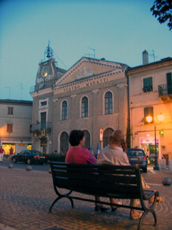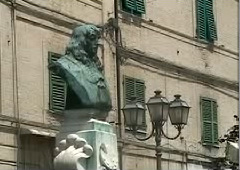Teatro Maratti restoration to re-make piazzaBY DANIELLE ABBOTT CAMERANO, Italy-- Many towns throughout Italy have a building that perfectly represents centuries of change and history within the town. In Camerano that building is the Teatro Maratti, a place that sparks memories of the past and dreams of the future. |
||||
|
Teatro Maratti at dusk. Photo by Kelly Erickson |
Construction of the theater, named for Carlo Maratti, the famous Baroque painter born in Camerano, began in 1870. After a long building process, it was finally completed in 1913. The Teatro Maratti was viewed as such an important part of Camerano, that a tower was built to house one of only two clocks in town; the other is on a local school. After its completion, the building fulfilled a greater purpose than a stage with seats and became the center of town, according to Alberto Recanatini, a local historian and author. When he was growing up, he remembers, the theater “was more important than the Town Hall. It was a neutral and non-political meeting ground for family, friends and neighbors.” |
|||
| The theater allowed Cameranesi of all ages and classes to entertain their families through poetry, plays, singing and dancing. After Sunday’s religious services, people flocked to the theater not only to fill the seats on the floor or in reserved boxes, but also to be peaceful, relax and talk to everyone at a central meeting place. Recanatini says the theater was also used in winter as a community fireplace. People would bring a small share of wood, and everyone’s logs, combined, would heat the crowd for hours. People were able to use a minimal amount of their wood supply, and enjoy local storytelling and dancing. Since many of the better-known actors and performers were from larger cities, people at the Teatro Maratti enjoyed the entertainment and talent of local performers. Some performers had much schooling and education, while others were uneducated craftsmen with little or none. Yet Camerano was so desperate for culture and entertainment, that class and social status were nearly non-existent within the Teatro Maratti. |
||||
|
During the end of the 1920s and into the 1930s, all of Italy began to evolve from theater to silent movies and the more modern cinema. For several years, the building offered both live theater and motion pictures. Near the end of World War II, the Teatro Maratti was showing only movies, and the building began to decline in popularity as the nearby city of Ancona showed the more important and popular films. |
Video by Mark Rowan |
|||
| The year 1946 brought one of the most traumatic events to occur in Camerano. A man who had just returned from the war, who was wanted by the police for selling merchandise on the black market, decided to attend the theater for an evening. Local police officers told him to stop as he was leaving the building, and when he refused, he was instantly shot dead. As the crowd of theatergoers stood shocked and horrified, they began to question the motives of the police officer who fired the fatal shot. Some people think excessive force may have been used because the officer was a rival black market seller. The homicide is the only one that has occurred in Camerano. | ||||
Home | About Camerano Project | Contact Us
Arts & Entertainment | Sports | Family & Faith | Commerce | Community Life | Index
Copyright ©2006 The Institute for Education in International Media


